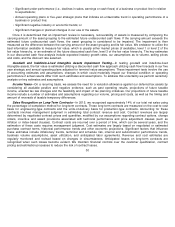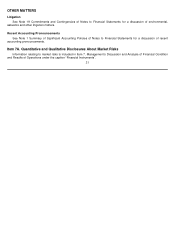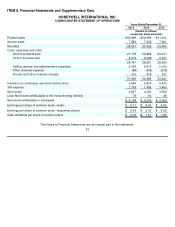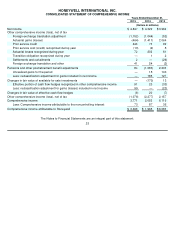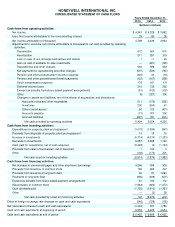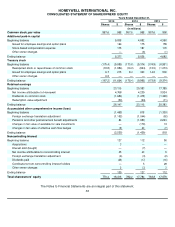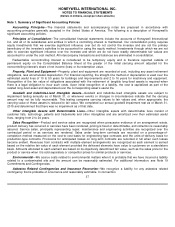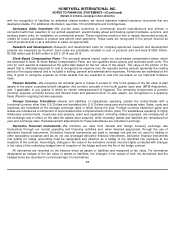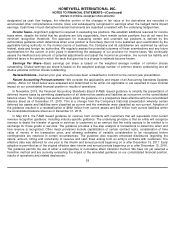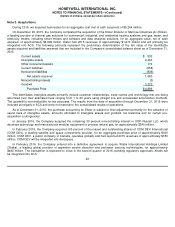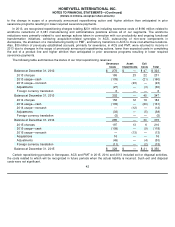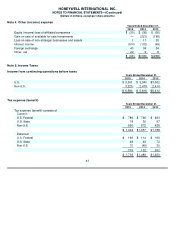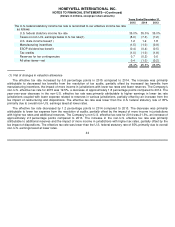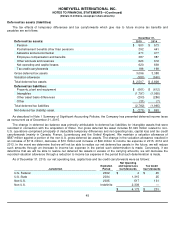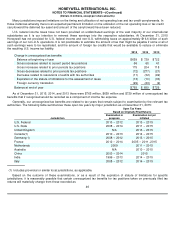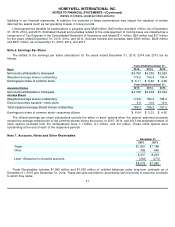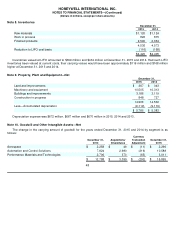Honeywell 2015 Annual Report Download - page 43
Download and view the complete annual report
Please find page 43 of the 2015 Honeywell annual report below. You can navigate through the pages in the report by either clicking on the pages listed below, or by using the keyword search tool below to find specific information within the annual report.
HONEYWELL INTERNATIONAL INC.
NOTES TO FINANCIAL STATEMENTS
—(Continued)
(Dollars in millions, except per share amounts)
designated as cash flow hedges, the effective portion of the changes in fair value of the derivatives are recorded in
accumulated other comprehensive income (loss) and subsequently recognized in earnings when the hedged items impact
earnings. Cash flows of such derivative financial instruments are classified consistent with the underlying hedged item.
Income Taxes—Significant judgment is required in evaluating tax positions. We establish additional reserves for income
taxes when, despite the belief that tax positions are fully supportable, there remain certain positions that do not meet the
minimum recognition threshold. The approach for evaluating certain and uncertain tax positions is defined by the
authoritative guidance which determines when a tax position is more likely than not to be sustained upon examination by the
applicable taxing authority. In the normal course of business, the Company and its subsidiaries are examined by various
federal, state and foreign tax authorities. We regularly assess the potential outcomes of these examinations and any future
examinations for the current or prior years in determining the adequacy of our provision for income taxes. We continually
assess the likelihood and amount of potential adjustments and adjust the income tax provision, the current tax liability and
deferred taxes in the period in which the facts that give rise to a change in estimate become known.
Earnings Per Share—Basic earnings per share is based on the weighted average number of common shares
outstanding. Diluted earnings per share is based on the weighted average number of common shares outstanding and all
dilutive potential common shares outstanding.
Reclassifications—Certain prior year amounts have been reclassified to conform to the current year presentation.
Recent Accounting Pronouncements—We consider the applicability and impact of all Accounting Standards Updates
(ASUs). ASUs not listed below were assessed and determined to be either not applicable or are expected to have minimal
impact on our consolidated financial position or results of operations.
In November 2015, the Financial Accounting Standards Board (FASB) issued guidance to simplify the presentation of
deferred income taxes by permitting classification of all deferred tax assets and liabilities as noncurrent on the consolidated
balance sheet. The Company has elected to early adopt the guidance on a prospective basis effective with the consolidated
balance sheet as of December 31, 2015. This is a change from the Company
’
s historical presentation whereby certain
deferred tax assets and liabilities were classified as current and the remainder were classified as non-current. Adoption of
the guidance resulted in a reclassification of $662 million from current assets and $32 million from current liabilities within
the consolidated balance sheet as of December 31, 2015.
In May 2014, the FASB issued guidance on revenue from contracts with customers that will supersede most current
revenue recognition guidance, including industry-specific guidance. The underlying principle is that an entity will recognize
revenue to depict the transfer of goods or services to customers at an amount that the entity expects to be entitled to in
exchange for those goods or services. The guidance provides a five-step analysis of transactions to determine when and
how revenue is recognized. Other major provisions include capitalization of certain contract costs, consideration of time
value of money in the transaction price, and allowing estimates of variable consideration to be recognized before
contingencies are resolved in certain circumstances. The guidance also requires enhanced disclosures regarding the
nature, amount, timing and uncertainty of revenue and cash flows arising from an entity
’
s contracts with customers. The
effective date was deferred for one year to the interim and annual periods beginning on or after December 15, 2017. Early
adoption is permitted as of the original effective date–interim and annual periods beginning on or after December 15, 2016.
The guidance permits the use of either a retrospective or cumulative effect transition method. We have not yet selected a
transition method and are currently evaluating the impact of the amended guidance on our consolidated financial position,
results of operations and related disclosures.
39


